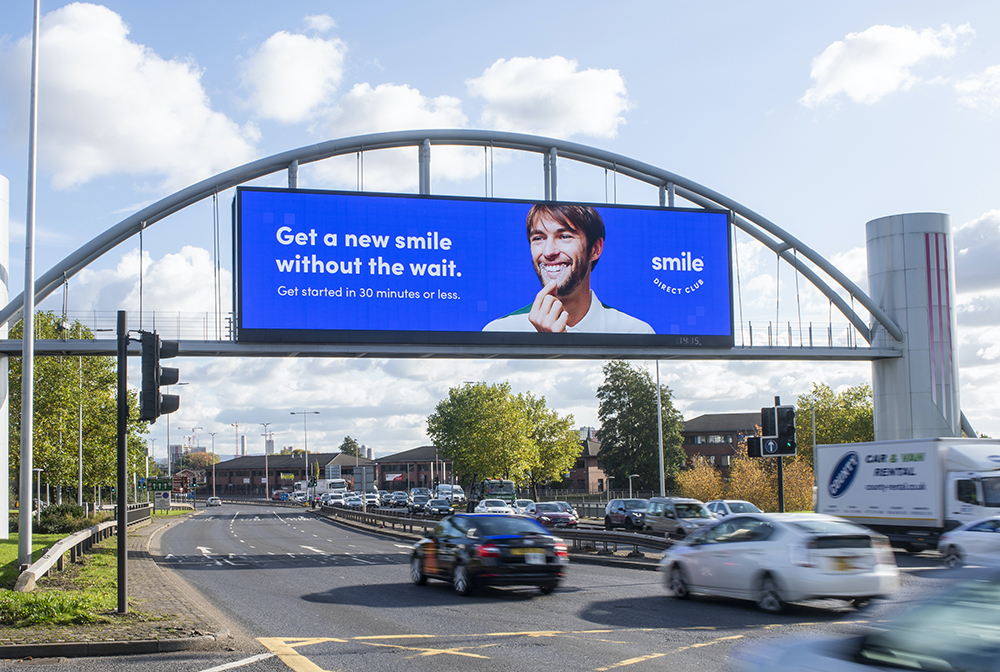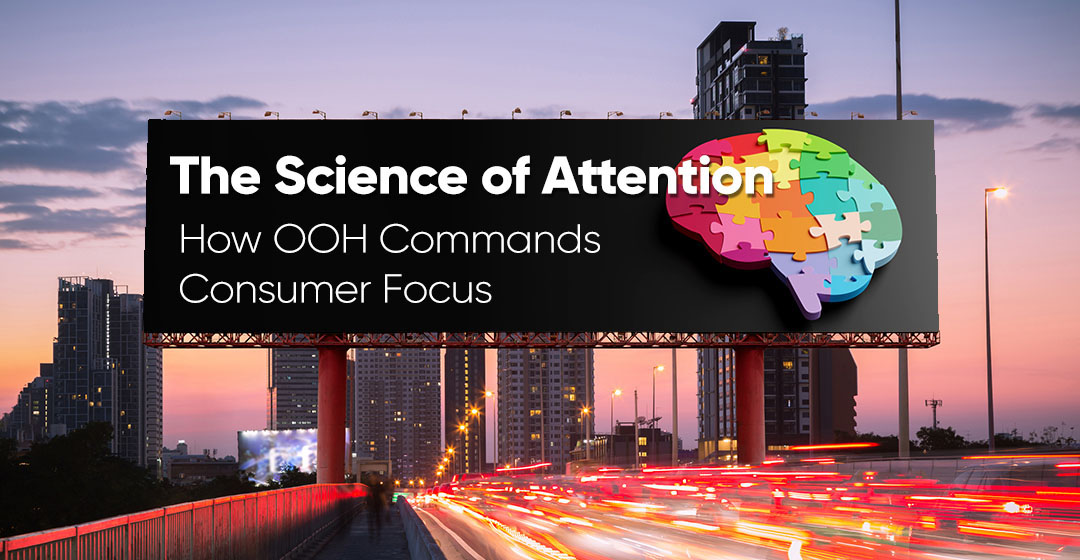Exploring OOH Advertising Effectiveness, its Attention Advantage and Influence on Recall, Consideration, and Purchase Intent.
In today’s hyper-connected world, attention has become the most precious commodity for marketing. With consumers juggling an avalanche of advertising messages daily across fragmented channels, capturing and holding their focus has never been more challenging—or more valuable.
While marketers fight tooth and nail for milliseconds of attention in cluttered feeds and banner-blind environments, Out-of-Home media (OOH) advertising operates in a fundamentally different arena. Free from distractions, OOH creates moments of undivided consumer attention that translate into measurable business outcomes.
What drives OOH advertisings effectiveness in keeping consumers’ attention? The answer to that question can be found in neuroscience, consumer psychology, and the unique physical properties of Out-of-Home itself. Let’s examine some of the reasons behind OOH’s ability to command attention and understand why savvy marketers are increasingly prioritizing this powerful channel.
The Neuroscience of Attention in Advertising
To understand the OOH advertising effectiveness, we need to start by examining how the human brain processes visual information. Our attention systems evolved over millions of years to help us survive—and these ancient mechanisms still drive modern consumer behavior.
Motion, for instance, triggers what researchers call a “primitive survival response.” Human vision evolved to detect motion first, as moving objects often signaled either threats or opportunities. A 2020 study published in Vision Research found that motion activates the superior colliculus region of the brain, which orients our gaze reflexively toward stimuli—even before we’re consciously aware of what we’re looking at.
This neurological reality gives OOH formats like digital billboards and transit advertising a significant advantage. When a creative element moves or changes, it hijacks our attention system in ways that static digital ads simply cannot match.
The brain’s dopamine system also plays a crucial role in attention capture. Research shows that alerting responses only occur for sensory cues that require examination to determine their meaning—not for intrinsically rewarding events. These alerting responses are enhanced when cues appear at unexpected times or locations, which explains why OOH placements in high-traffic areas can be so effective at breaking through mental filters.
Unlike digital environments where consumers have learned to ignore banner spaces and scroll past sponsored content, physical advertising spaces haven’t been “trained out” of our attention systems. The brain still treats them as novel environmental elements worthy of processing.

What Makes Out-of-Home Media So Memorable?
The ability of OOH to command attention isn’t just an idea—compelling research data backs it. A 2023 study by Ocean NeuroScience showed that consumers are 2.5 times more aware of OOH media when compared to digital ads. Even more impressive, PML Group’s IMPACT Attention study found that Out-of-Home media successfully captured the attention of 83% of consumers.
Several factors contribute to OOH advertising’s effectiveness:
- Size and Scale: Out-of-Home media has one major advantage right out of the gate, and that is its sheer scale. A 14×48-foot billboard can’t be avoided. It will remain in view the entire time a consumer passes by.
- Strategic Placement: OOH media is typically located in high-traffic locations where consumers are moving through their daily lives. Unlike digital ads that interrupt browsing, OOH is an integral part of the physical environment that consumers actively navigate.
- Creative Boldness: The sheer size of Out-of-Home media encourages big, bold creative. Striking visuals, bold colors, and innovative installations that would be impossible to execute effectively in small digital formats are perfect for OOH.
- Dwell Time Advantage: Whether consumers are stuck in traffic, waiting for public transport, or walking past street furniture, OOH often benefits from extended exposure periods where the audience has little choice but to engage with the surrounding environment.
Perhaps most importantly, OOH environments typically feature fewer competing messages than digital spaces. While a single webpage might contain dozens of advertising elements, a billboard stands alone in its physical space, commanding undivided visual attention from passing consumers.
OOH Advertising’s Effectiveness: High-Quality Impressions
In digital advertising, impressions are often treated as a volume game—the more eyeballs, the better. But OOH operates on a different principle: quality over quantity. The medium excels at creating what researchers call “high-quality impressions”—moments of genuine attention rather than mere exposure.
Eye-tracking studies provide compelling evidence of this advantage. The Arbitron Outdoor Study found that digital billboards generated 63% longer gaze time than static billboards and 47% more visual fixations. When consumers do notice OOH advertising, they engage with it more deeply and for more extended periods.
One powerful example comes from Limited Space’s eye-tracking study of their elevator advertising media. The research found that 100% of consumers who took the elevator engaged with the media for an average of 5.32 seconds, resulting in a 68% recall rate. This amount of engagement is extremely difficult to achieve in most digital environments, where average view times are measured in milliseconds.
The difference between a “view” and an actual meaningful impression is crucial for memory encoding. Neuroscientists have found that meaningful brand memories require sustained attention—something that OOH’s physical presence and strategic placement naturally facilitate. When consumers encounter OOH advertising repeatedly on their daily commutes or regular routes, these prolonged and repeated encounters build stronger memory encoding than brief digital exposures.

The Impact on Brand Recall and Recognition
The attention advantages of OOH translate directly into superior brand recall and recognition rates. According to a comprehensive study by the Outdoor Advertising Association of America (OAAA) and Solomon Partners, OOH achieves the highest percentage of consumer recall at 86%—outperforming radio, podcasts, online ads, and TV streaming.
Nielsen research provides more evidence. Studies show that OOH can achieve a 47% brand recall rate. This compares to just 35% for digital media – a significant advantage. This difference represents a substantial improvement in creating brand awareness.
The superior recall rates stem from several psychological factors. For starters, the physical existence of Out-of-Home media creates stronger memories. When someone remembers seeing a billboard, they also remember the context of that experience—the location, the time of day, perhaps even what they were doing when they saw it. The context of these memories makes the brand association stronger and more familiar.
Second, OOH’s role in daily routines creates natural patterns of repetition. Commuters might pass the same billboard twice daily for weeks or months, creating the kind of spaced repetition that memory researchers know is most effective for long-term retention. This repeated exposure enables OOH advertising effectiveness, allows brands to reinforce slogans, logos, and key campaign messages in a way that random digital encounters cannot match.

Moving Down the Funnel: Consideration and Purchase Intent
While awareness and recall are essential, modern marketers need to demonstrate bottom-funnel impact. Fortunately, OOH delivers here as well. Attribution data shows that OOH increased purchase intent by 10% to 35% across various campaigns, depending on category and creative execution.
A comprehensive five-year study by Clear Channel and Kantar found that OOH matches linear TV in driving favorability and purchase intent while delivering TV-like impact at a more efficient price point. This finding challenges the traditional media hierarchy, positioning OOH as a primary medium rather than a supporting player.
Out-of-Homes’ ability to create this impact comes from the fact that it reaches consumers at very particular moments. Digital media is often encountered while people are actively engaged in other activities – such as scrolling through social media, reading an article, or checking email. OOH reaches consumers when they are less distracted and often heading out to shop.
Savvy marketers are increasingly synergizing OOH with digital touchpoints to create measurable response mechanisms. QR codes on transit advertising allow immediate mobile engagement. Location-based digital campaigns can retarget consumers who’ve been exposed to nearby billboard campaigns. Even simple calls-to-action, such as “Search [Brand Name],” create trackable mobile search uplift that can be directly attributed to OOH exposure.
Case studies consistently demonstrate OOH’s ability to drive concrete actions: increased store visits in retail campaigns, app downloads for mobile services, and website traffic spikes that correlate with billboard flight schedules. The key to using Out-of-Home media is not to treat it as a standalone medium, but rather as part of a larger, integrated campaign.
Best Practices: Maximizing OOH Advertising Effectiveness
Understanding the science of how OOH commands attention is one thing—applying it effectively is another. Research has shown some best practices that help optimize the medium’s attention value.
The Three-Second Rule: A joint study by GroupM, OOH, and Lumen showed that as little as three seconds of attention resulted in a 26% increase in brand recognition. This highlights the power of immediate visual impact.
- Seven Words or Less: Research has shown that the most effective OOH designs limit text to seven words or fewer. High-contrast color combinations can improve recall by up to 38%, making color choice a critical strategic decision rather than just an aesthetic one.
- Location Strategy: Not all locations are created equal. High-traffic areas provide more impressions, but high-dwell locations—areas where consumers are naturally stationary or moving slowly—often provide higher-quality attention. The key is matching location characteristics with campaign objectives.
- Creative Tactics: Simplicity remains king in OOH creative, but that doesn’t have to mean. Out-of-Home offers a blank canvas that can be adapted to truly unique creative ideas. The need for simplicity can also help drive creativity by forcing different ways of thinking.
- Measurement and Optimization: The old days of “spray and pray” OOH campaigns are over. Modern successful campaigns incorporate ongoing measurement—from foot traffic analysis to mobile location data to direct response tracking—allowing for real-time optimization and performance improvement.

OOH Advertising Effectiveness: The Lasting Power of Physical Presence
As we look to the future of advertising, the advantages of OOH are becoming even more pronounced. Digital-out-of-home (DOOH) combines the attention benefits of physical presence with the targeting and creative flexibility of digital media. Australia’s Outdoor Media Association neuroscience study found that advertising seen on digital signs delivers 63% more impact than traditional signs, proving that DOOH signs can have a meaningful effect in just a one- or two-second glance.
Dynamic creative capabilities add another layer of effectiveness. A QMS/Neuro-Insight study showed that evolving creative delivered 38% higher impact than static creative by day five, with long-term memory encoding continuing to grow with repeated exposure. This suggests that DOOH’s ability to refresh and adapt creative content creates cumulative attention benefits over time.
In today’s saturated media landscape, OOH advertising effectiveness and its unique ability to cut through the noise and command real consumer attention create a significant competitive advantage. Out-of-Home media creates concentrated moments of focus that drive real business results.
For marketers seeking maximum impact in an attention-scarce world, the evidence is clear: prioritizing attention-first OOH strategies isn’t just clever marketing—it’s essential for cutting through the clutter and connecting with consumers when and where it matters most. The science of attention strongly favors the power of physical presence, making OOH an indispensable component of any comprehensive media strategy.

